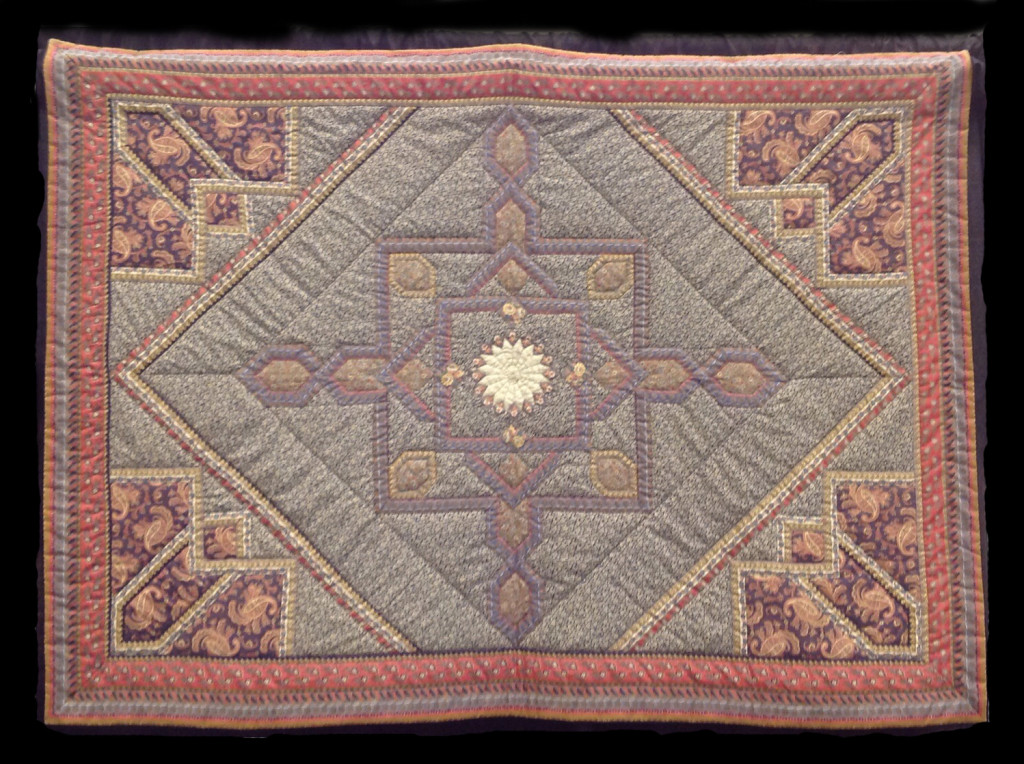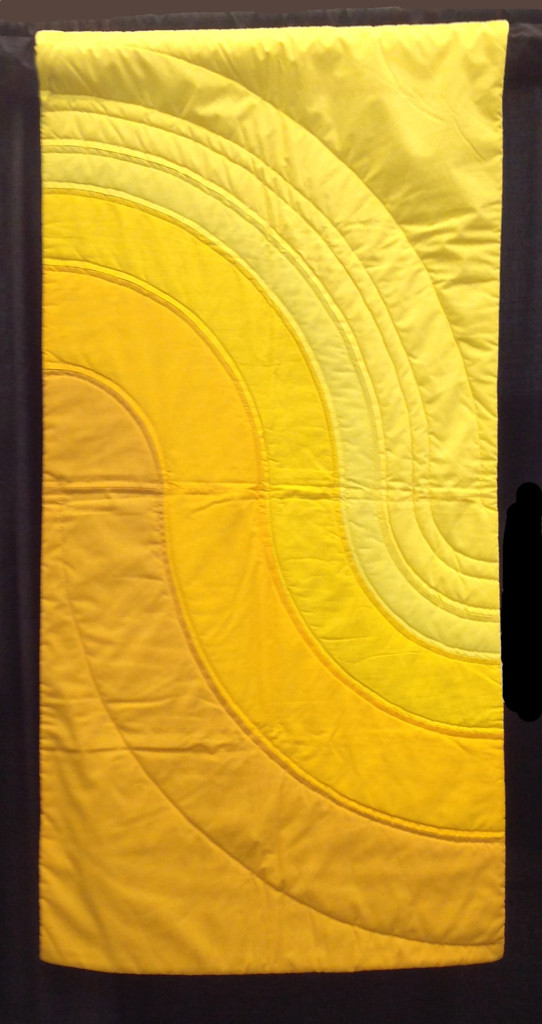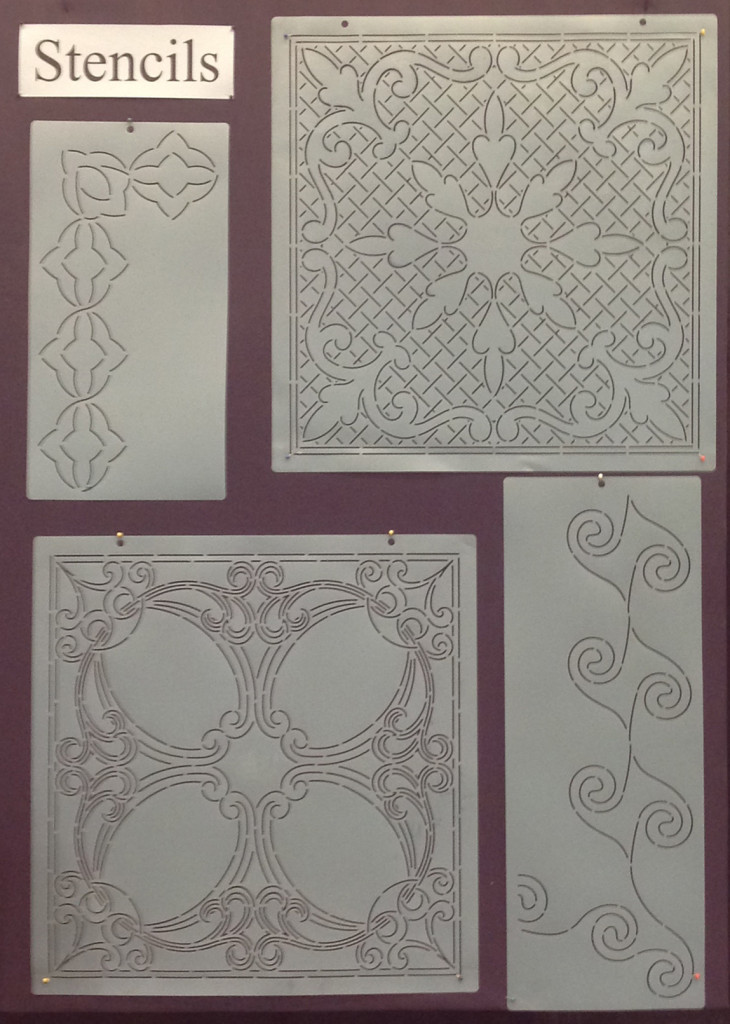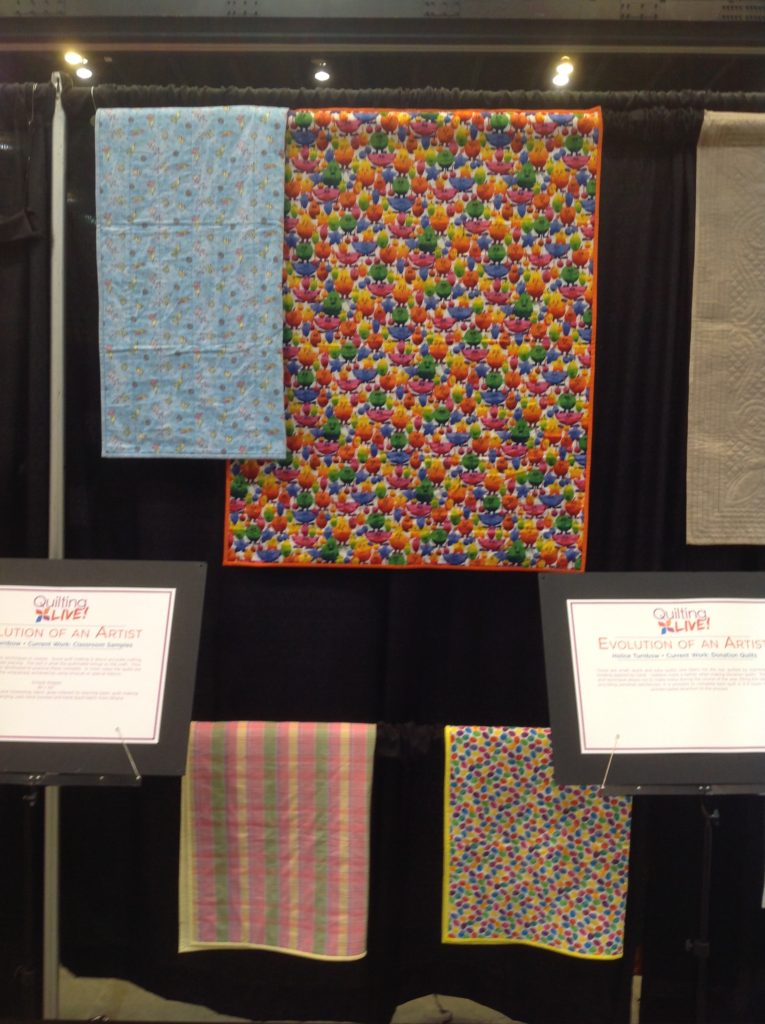 One’s quilt making career might be described as ice cream. It can be plain vanilla, chocolate or strawberry. However, as skill and interest develops the whipped cream of new techniques; the mix nuts of styles and then the succulent cherry on top becomes a delicious banana split or ice cream sundae.
One’s quilt making career might be described as ice cream. It can be plain vanilla, chocolate or strawberry. However, as skill and interest develops the whipped cream of new techniques; the mix nuts of styles and then the succulent cherry on top becomes a delicious banana split or ice cream sundae.
As I look back on the past 42 years my work has all the elements of the complete sundae with a wide variety of techniques and styles.
I never made bed quilts for myself. My household didn’t need them for everyday use since those we used had been given to me by aunts who were prolific quilters. This left me to experiment and stretch. Instead, I made for friends and special events. Teaching helped add a variety to my work as quilt making styles changed.
Please enjoy seeing some of the results of my journey and delight in the occasional cherry on the top of my ice cream sundae I call quilt making.
If you want to get in touch with me my email is:
edwaquilt@aol.com
In September 2014 I participated in a special quilt exhibit at Quilting Live in Atlanta, Georgia. The event was organized by The Original Sewing and Quilting Expo of Cleveland Ohio. The Expo is one of the units of F&W Publishing. F&W publishes several of the popular quilting magazines as well as owning Keepsake Quilting in New Hampshire and Fons & Porter in Iowa. I was one of six quilters invited to be part of this very special exhibit.
I was at a loss, when invited, to know what I might contribute since others in the exhibit were well known and popular quilt designers. They all had won major prizes and exhibited both here in the US as well as overseas. As I thought through my quilting life, I decided to organize the exhibit in units of specific quilting activities I had been part of over my 40+ years as a quilter. Those activities include designing whole cloth, stencils, magazine articles, clothing and charity work.
SECTION 1 – EARLY QUILTS
Horse
Size 48”x52”
This is my first quilting piece. It was designed and made for a special exhibit titled “The Horse in Needlework” held in the Old Executive Mansion in Bowie, Maryland.
Bowie, Maryland was and perhaps still is the site of one of the oldest horse racing events in America.
Machine pieced border and hand quilted. Fabric is poly-cotton.
The Navajo Rug
Size 80” x 94”
This quilt was inspired by a traditional Navajo Rug. The colors were selected to represent the natural dying of the yarn used to weave the rugs. Horizontal quilting with thread in the colors of the background adds to the woven look.
Designed and pieced by Holice Turnbow and hand quilted by the Rural Arts and Crafts Co-op in Parkersburg, WV.
Oriental Rug
Size 60″ X 42″

This wall hanging design was inspired by a Heriz style/design Oriental rug.
All the fabric except the corner pieces came from one collection printed by Concord Fabrics. Sections of the border print were recut for additional borders around various sections of the quilt. The design was drawn full-size on graft paper and individual templates made for each section of the design. The quilt is both machine and hand pieced and hand quilted.
Drunkard’s Path
27″ X 52″
From the beginning of my quilt making career I tried to design outside the boundaries of traditional quilting. The inspiration for the piece was the traditional Drunkard’s Path design, but with added bands and with the block reversed. The fabric is a combination of poly-cotton and rayon-cotton blends.
The combination of blended fabrics calls for additional quilting to give stability to the layers. This wall hanging was the first piece I ever entered in a judged quilt show. I received one comment from the judges who said there should not have been a seam where the two sections joined. Of course, the object of the design was to join two blocks in reverse. I quipped that it should have been obvious to the judges that this design represented two drunks holding hands.
Machine pieced and hand quilted.
Triple Irish Chain
48″ X 60″
This quilt was designed for a special exhibit of West Virginia artists for the Union Carbide Headquarters in New York City. The quilt was strip cut using a dressmaker’s board for accuracy, marked with pencil and cut with scissors. This was before rotary cutters and acrylic rulers came onto the quilting scene. The fabrics are a mixture of poly-cotton, rayon cotton blends and cotton. When it was made it was necessary to use different fiber combinations to get the gradation of color needed in the piece.
A unique feature of its construction is the method used to tie the layers together. After the layers were sandwiched, each row of blocks was folded back and hand basted through the seam allowance into the batting and back. This method was used in order to not leave another dimension on the surface.
SECTION 2 – QUILTING STENCILS
I began to design quilting stencils for The Stencil Company when their manufacturing source discontinued operation. The manufacturer’s catalog contained primarily quilting designs which had been available in printed form or handmade by individual quilters.
The company was not adding new designs to their inventory.
New designs were traditional or generic style motifs as well as original designs to complement quilt patterns and recognize trends in quilting styles.
Voices Of The Past Stencils
This section features a few stencils which were designed for the book “Voices Of The Past” Vol I and II (A History of Women’s Lives in Patchwork), by Kaye England.
The book chronicles women of the past who were outstanding in their careers; were part of history and through their lives influenced the lives of people in their own time as well as ours. The biography of each woman was read for events in her life to use as inspiration for the design of their stencil or series of stencils.
– Helen Keller loved roses. This design reflects that love.
– Harriet Tubman was instrumental in the Underground Rail Road events during the American Civil War. In talking with a cousin who was an elementary school teacher, she told me about those who were escaping hid in hay stacks and took circuitous routes on their travel to freedom.
This border design represents the hay stack and round about route of their travel
– Dolly Madison was a very social person with parties and other social events during her husband’s presidency. An architerical design popular during the period was the “Egg and Dart”… These stencils were based on that detail.
– Lucille Ball was a Star.
– Queen Charlotte’s design reflected the crown of her royalty.
– Madam “C.J.” Walker was the first to develop cosmetics especially for African-American women. This design represents the elegance of her life and the pride of those who used her product.
SECTION 3 – THE POSTAGE STAMP QUILT
In 1978 the US Postal Service issued a block of four stamps commemorating quilting as an American Folk Art. The stamp was designed by Christopher Pullman of Boston. The First Day of Issue events were held at the Cultural Center in Charleston, WV. I lived in West Virginia at the time and was invited by the WV Director of Culture and History to curate a quilt show in conjunction with the event. West Virginia quilters were asked to submit quilts for an exhibit of postage stamp and basket designs since the stamp depicted four pieced baskets.
While the design of the stamp was kept a secret until unveiled at the event, I was able to obtain permission from the USPS to draft a pattern of the block and have blocks made to be sold on the day of issue of the stamp. The Rural Arts and Crafts Association in West Virginia made the blocks. The blocks were framed with a sheet of stamps included and sold in the Cultural Center’s Gift Shop. I am told these blocks are now turning up in antique shops in West Virginia. Those of us who were involved in the event were hosted at the Executive Mansion by Sharon Rockefeller, wife of the Governor.
The design of the stamp was based on an antique quilt in the collection of America Hurrah, an antique shop in New York City. The artist chose four of the basket blocks to provide a pleasing combination for the final design. No single block like the stamp can be found in the original quit. The quilt dates from mid 1800’s and is now in a private collection. The original quilt was on display during the event.
THE STAMP QUILT
74”x88”
The quilt pictured here is a reproduction of the original quilt. Reproduction fabrics of the period were chosen to make an authentic quilt. Piecing was by Avis Meckus of Southbridge, MA and hand quilted by Martha Darr of Dexter, MI.
Several months before the stamp was issued, I received a call from the USPS saying they were looking for a quilter from West Virginia because they planned to issue a postage stamp commemorating quilting as folk art. My name had been given to them by the Stamp Editor of the Washington Star newspaper. His wife was a quilter whom I had met.
The USPS was looking for a location in West Virginia where there might be some other event scheduled and they could tie into the event the stamp issuance. I lived in Shepherdstown WV at the time. I began calling around to find out scheduled activities but when I called and talked to city officials in Harpers Ferry, the call was referred to the mayor. He was very quick to tell me that he would take over the contacts as he had worked for the Postal Service. This is the first time I realized the political impact of stamp issuance. 1977 was still the time when the design and plans were kept a secret until the day of issue. However, I kept in touch with the Postal Service representative and was able to get a copy of the design. They gave permission for a group to make a block of the stamp design to sell on the day of issuance. This was almost unprecedented at that time. I worked with the Rural Arts and Crafts Coop in WV who made the block. They were framed and when stamp was available, added a sheet of stamps to the back. I am told these are now occasionally found in antique shops and sold as blocks from the quilt.
The decision of the location was eventually given over to Senator Jennings Randolph and the Cultural Center in Charleston was given the honor. I was then asked by the folks at the Cultural Center to organize an exhibit for the day of issuance. The call was put out in West Virginia for quilts of postage stamp and basket designs. Many quilts came in for the exhibit. Interesting thing about the quilts was many were made of double knit with some having navy tricot as backing. There had been many garment factories in WV so that was the fabric available. Most of the quilts had to be hung high on the walls of the main entrance to the Cultural center so they looked like modern art. There was a problem hanging them as the walls were marble or granite. One of the workers solved the problem by putting a strip of duck tape on the wall with a second strip on top and the quilts were pinned into the duck tape. The exhibit was awesome and included the quilt from which the stamp design was taken.
Christopher Pullman, an artist from Boston had been chosen to do the design. He had done work for the Postal Service designing the annual Duck Stamps. He said that his first design was a full size quilt that would be sectioned into individual stamps on the sheet. This was rejected so he went to American Hurrah in NYC and selected the stamp quilt. There are no 4 stamps on the quilt with the exact arrangement as on the stamp. He picked four that would blend in color or design.
On the day of issue we who were on the committee were invited to the Executive Mansion for lunch with Sharon Rockefeller. This was a thrill, not only to be close to the First Lady but also to see the quilt made for her by Cabin Creek which was probably one of the most recognized quilts at that time.
There was a presentation with speeches in the afternoon when the Cultural Secretary introduced the designer. Sharon made a speech and the rest of us were sitting on the stage.
An embarrassing moment was when the Cultural Secretary, reading the names in the program book, discovered the artist’s name had been left out.
After the speeches we were asked to go down from the stage for the public to chat. I was on the end of the line and one little lady stopped in front of me and looked up and said “are you anybody” It sure burst my ego bubble.
This is a reproduction of the quilt stamp. Fabrics were available to make a reasonable reproduction of the baskets in the stamp. These were made and sold in the West Virginia Cultural Center’s gift show during the time the exhibit was on display.
SECTION 4 – QUILT CRAFT MAGAZINE DESIGNS
During 1992 and 1993 I designed and made a series of small quilts for Quilt Craft magazine. The focus of the project was on small and easy designs using various techniques and fabrics. Each quilt was designed to use fabrics one might not select for a quilt – precuts, bias tape, unusual fabric designs and colors. While many of these techniques were not common at the time they are routinely used by today’s quilt makers.
The fabric usually became the inspiration for the design and the technique “different”.
I learned two basic concepts from the project – easy can be exciting and creativity can be in simple things.
THE QUILTS
THE STORY QUILT
42”x59”
The fabric often became the inspiration for a quilt. In this quilt, a circus print was used (a second quilt was made of fabric printed with A, B, C’s). A series of various sized rectangles and squares were drawn to give a variey of shapes to the single fabric in the body of the quilt. The underlying intent was to use the quilt as a learning tool as a child was tucked in for the night. Talking and describing the things seen at a circus could stimulate a child’s imagination.
A Closeup of Story Quilt:
JUNGLE
40”X48”
A single print was used for the base of this quilt. I imagined seeing the animals through an attic window. Since I was not very good at accurately piecing mitered corners, a “mock attic window” technique was used by folding the corners to create the miter. It worked and was much faster in making the quilt.
SUNRISE – SUNSET
38”x46”
I was given the blue sky print and for weeks wondered how it might be used. Then I remembered making another quilt using bias tape. The thought of sunrise and sunset came to mind. Each block was designed using a quarter circle combined with the bias making the sun rays. Totally machine made.
HEARTS
42”x55”
In the early 1990’s precuts were limited to those shapes that could be used for appliqué. Many vendors at shows and in shops would have various die cut packages. I wanted to design and make a quilt using all pre-made fabrics. A grid was laid out on the background fabric to create block areas. The hearts were appliquéd in the center of each grid and the sashing was strips of packaged bias tape. The layers were secured with ties of embroidery floss, thus adding some additional embellishment to the overall design.
Section 5 – The Donation Quilts
Donation Quilts – These are small, quick and easy quilts. One fabric for the top is selected for the top, quilted by machine, and binding applied by hand. I believe more is better when making donation quilts. The style and technique allows me to make many during the course of the year, filling the need and giving personal satisfaction. It is possible to complete each quilt in 3-4 hours if I give uninterrupted attention to the process.
DONATION QUILTS
Each is approximately 36”x42”
Simple one piece top of bright and colorful fabrics, machine quilting and hand applied binding.
Section 6 – Garments
Fairfield Fashion Show
This cape was designed and made for the Fairfield Fashion Show. The quilting design was adapted from an antique Christening quilt in the collection of the Museum of American Folk Art, Smithsonian Institution. It is from a Vogue pattern using silk pongee, Fairfleld cotton/poly batting and quilted with rayon thread
P&B Clothing Exhibit
Each garment had to include all prints and coordinating solids in one color way of the fabric line. Thus, this piece has 7 prints and two in its three pieces. The garment was designed and made for a special exhibit sponsored by P&B Fabric Company to be shown at a Fall Quilt Market.
Section 7- Whole Cloth Designs
In the early 1990’s I was approached by a South Carolina fabric company with the question, “is it possible to preprint a full size quilt design”. My answer was “Yes, if you have the printing technology”. This began the whole cloth project. There were 5 designs created and printed during the initial release of the project. For the first time a wash-out ink was used in the printing which made the product more attractive to quilt makers.
Three designs were acquired from quilt markers in Virginia and Pennsylvania with additional designs created especially for the project. Both full and wall hanging sizes were printed. Later, arrangements were made with the Museum of American Folk Art at the Smithsonian Institution to adapt designs from their quilt collection. This was primarily done to bring classic designs to the quilting public but also to offset the publicity created when the Smithsonian contracted to have some of their quilts reproduced overseas. These designs were available for a limited time. The second phase of the project was with a New York City fabric company. Several designs were created and the availability has continued.
Pineapple Delight
(Pre-printed quilt top)
90″ X 108″
Miniature Whole Cloth Designs
16.5″ X 16.5″
These designs are printed as mini whole cloth and as stencils.
Cana Lily
40″ X 40″
Inspiration for all of the whole cloth designs came from antique and vintage sources and combinations of classic motifs into new designs.
Section 8 – Current Work
CLASS PROJECTS
Classroom Samples – I concentrate on basic techniques in classes. Good quilt making is accurate cutting or measuring and accurate piecing. The rest is what the quilt maker brings to the craft. Thus, classroom projects are developed to practice these concepts. In most cases the quilts are simple with the uniqueness achieved by using unusual or special fabrics.
SIMPLE SHAPES
36”X42”
Strip piecing, easy cut and interesting fabric gives interest to learning basic quilt making skills. This wall hanging uses hand loomed and hand dyed fabric from Ghana.
I have always tried to design outside the normal perimeters of traditional quilt making. I modify the design, change the size, and use special fabrics to give a fresh look to the quilt.
Rainbow Dahlia
40”x40”
The Rainbow Dahlia is a redesign of the traditional Giant Dahlia pattern. The redesign has 12 rays or petals rather than the traditional 16 to accommodate the three primary and three secondary colors in a graduated order. Each ray or petal has only 4 pieces thus reducing the number of sections to cut requiring less piecing. Construction can be either by hand or machine. 48 different prints are used in this sample or using a single color in four values makes a unique overall design. Special quilting stencils were designed for the piece. Surrounded by black, the design makes for a dynamic wall hanging or center of a larger quilt
Designed, made and quilted by Holice Turnbow























